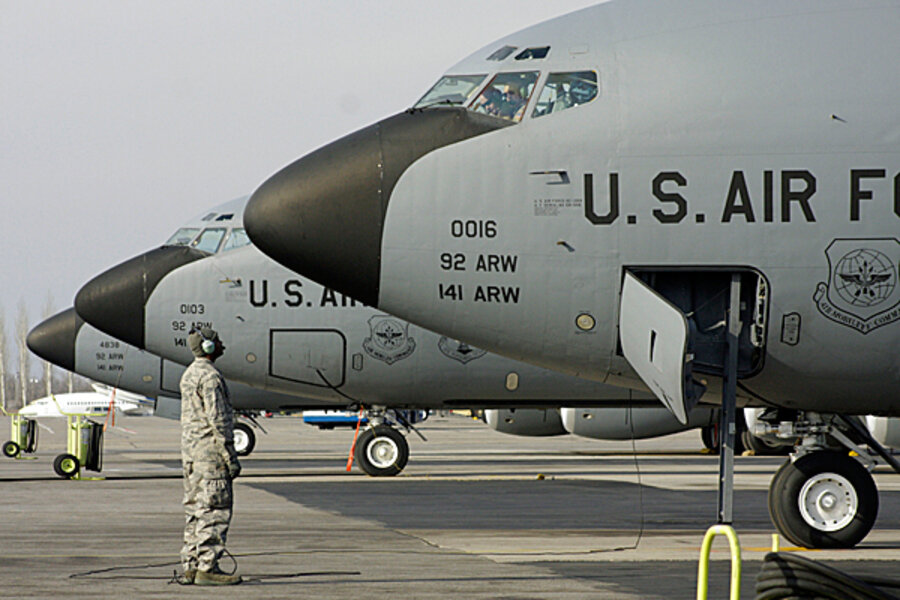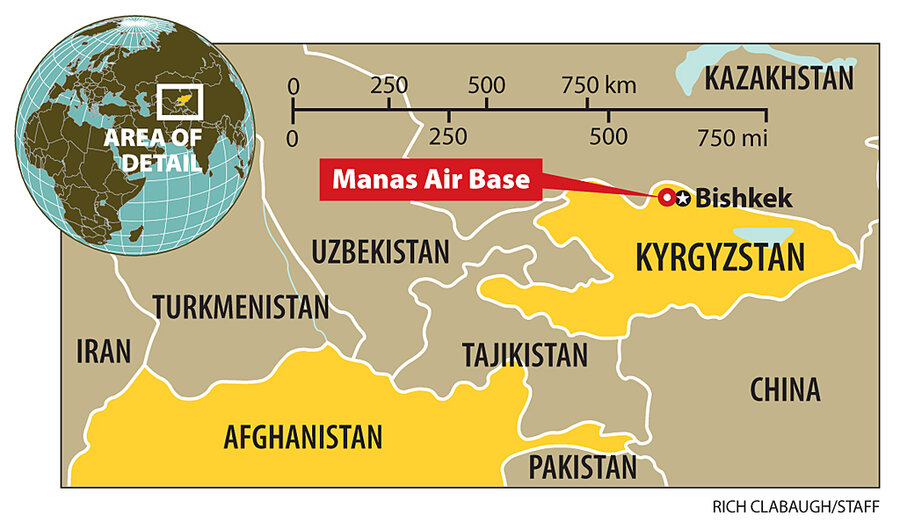Can US supply Afghanistan war without Kyrgyzstan's Manas airfield?
Loading...
| New Delhi
Opposition forces have forced the president of Kyrgyzstan to flee the capital and have declared a new interim government. Having taken over government buildings, they are now trying to solidify their overthrow and gain international recognition, though events remain fluid.
The US has a major interest in the Central Asian nation: Manas airbase, a key transit hub for NATO soldiers and weaponry into Afghanistan.
Here’s a look at what the turmoil in Kyrgyzstan may mean for the US supply route into Afghanistan.
Will the toppling of the Kyrgyz government mean the loss of Manas airbase?
Experts are divided. On the one hand, the country’s post-Soviet politics involves clans vying over which powerful families will gain control over state businesses. That history suggests the new clan rising to power will want to renegotiate the lucrative deal with the United States, says Theodore Karasik, a Central Asia expert at the Institute for Near Eastern and Gulf Military Analysis in Dubai.
“It raises the possibility of having to renegotiate access to Manas again because these clans just want more money,” he says. “This was a big source of income for these families who came to power” the last time.
The US pays $60 million in rent, and nearly triple that in fuel fees – money that had been flowing to relatives of toppled president Kurmanbek Bakiyev. Those deals came after Mr. Bakiyev threatened to close the base in 2009, several years after he seized power in a similar popular uprising.
Other analysts disagree that a new deal will have to be negotiated. They say the interim government set up by the Bakiyev’s opposition still needs to unify Kyrgyzstan’s domestic divisions and win international backing.
“If the opposition talks about closing Manas they would burn their bridges with the West before building them,” says Oksana Antonenko, a Russian specialist with the Institute of International Strategic Studies in London. She adds: “The people who are putting this unity government together, I don’t think they are corrupt and looking to enrich themselves.”
How would the loss of Manas impact the US war effort in Afghanistan?
Manas became more crucial after Uzbekistan closed a similar base to the US military in 2005. NATO shifted the operations from Uzbekistan – refueling, moving troops and ammunition – to the Afghan airbase at Bagram.
A Manas shutdown would further strain the now-crowded Afghan base at a time when the US is still surging troops into Afghanistan. Security is also more of an issue at Bagram than at a base located outside the warzone.
Few other air bases in the region can handle the massive, long-haul planes that the former Soviet base of Manas can accommodate.
“The closure of Manas would be a big blow. That is why Gen. Petraeus and Gen. McChrystal and others have invested a lot in trying to persuade Bakiyev the former president not to close the base,” says Ms. Antonenko.
Hasn’t the US developed alternative supply routes?
Yes, but only for supplies like food and clothing – not troops and ammo.
In early 2009, around the time when Bakiyev threatened to close Manas, the US military trumpeted the development of a new of supply routes collectively known as the “northern distribution network” (NDN).
The issue became associated in the press with the Manas dispute, but the US developed the NDN in response to rising attacks on the supply route from Pakistan through the Khyber Pass.
Over the past year, the Pakistani military has pushed back the militant groups responsible for attacking NATO convoys. Attacks still occur, however, including one Wednesday in which the Taliban attached a bomb to a fuel tanker, killing a boy riding in a van behind.
Meanwhile, the NDN has begun to grow. As of November 2009, the NDN has moved 4,500 containers to Afghanistan, which represents 12.5 percent of containers that came through Pakistan in 2008, according to a December report from the Center for Strategic and International Studies (CSIS) in Washington.
Could the new supply routes pick up traffic diverted from Manas?
No, says Antonenko. These are long, expensive overland routes quite distinct from the Kyrgyz airbase, and, as such, carry different things.
The NDN actually involves three spurs. One route goes from the Latvian capital of Riga, a major Baltic seaport, then overland through Russia, Kazakhstan, and Uzbekistan. A second route goes from the Caucasus, starting in Georgia, moving through Azerbaijan, crossing the Caspian Sea by boat, then rolling across Kazakhstan and Uzbekistan. The third option bypasses Uzbekistan by going from Riga to Kazakhstan, then through Tajikistan and Kyrgyzstan.
But the agreements with these nations do not include the right to move weaponry, nor would troops be moved through these corridors. Nor would the US necessarily trust these routes for sensitive materials: Night-vision devices, communications equipment, ammunition, and weapons are not sent through Pakistan, according to the CSIS report.
Nor do these train and truck networks provide a place to land and refuel airplanes.






